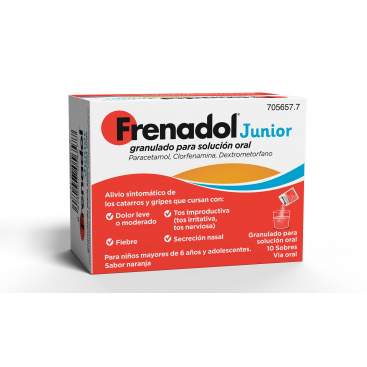Frenadol Junior 10 Sachets
Frenadol Junior for kids is a cold and flu remedy designed for children aged 6 to 11 years. It relieves fever, pain, cough, and nasal congestion with its powerful combination of paracetamol, chlorphenamine, and dextromethorphan.
Frenadol Junior for kids is a cold and flu remedy designed for children aged 6 to 11 years. It relieves fever, pain, cough, and nasal congestion with its powerful combination of paracetamol, chlorphenamine, and dextromethorphan.
Frenadol Junior 10 Sachets (English)
You can buy Frenadol Junior 10 Sachets online from UK, Austria, Belgium, Cyprus, Estonia, Finland, France, Germany, Greece, Ireland, Italy, Latvia, Lithuania, Luxembourg, Malta, the Netherlands, Portugal, Slovakia, Slovenia and Sweden.
Product Sheet: Frenadol Junior 10 Sachets
What is Frenadol Junior and What is it Used For?
Frenadol Junior for kids is a cold and flu medication specially designed for children aged 6 to 11 years. It combines an analgesic, an antipyretic, an antihistamine, and a cough suppressant to effectively relieve symptoms such as fever, mild to moderate pain, nasal congestion, dry cough, and runny nose.
This product is ideal for managing symptoms caused by common colds or flu, ensuring children can recover comfortably and quickly.
Frenadol Junior: Composition
Each sachet of Frenadol Junior contains:
- Paracetamol: 300 mg (pain reliever and fever reducer).
- Chlorphenamine maleate: 2 mg (antihistamine for allergic symptoms).
- Dextromethorphan hydrobromide: 10 mg (cough suppressant).
Additional ingredients include sucrose and yellow-orange S coloring, which may cause allergic reactions in sensitive individuals. Please refer to the full Frenadol Junior prospectus for a detailed list of excipients.
How to Use Frenadol Junior
The recommended dosage depends on the child’s age:
- Children aged 6 to 11 years: 1 sachet every 6-8 hours, not exceeding 4 doses daily.
- Children under 6 years: Not recommended, as safety and efficacy have not been established.
Instructions for preparation:
- Dissolve the sachet contents in half a glass of cold water.
- Administer immediately after preparation.
- Begin treatment as soon as symptoms appear and stop once they subside.
Tip: Give the last dose before bedtime for better comfort.
Who Should Not Take Frenadol Junior?
Avoid using Frenadol Junior for kids if the child:
- Is allergic to paracetamol, opioids, or other components of the medication.
- Has liver conditions such as hepatitis or liver failure.
- Is currently taking MAOIs or SSRIs.
- Has inherited fructose intolerance or malabsorption issues due to sucrose content.
Always consult a doctor before use if your child has chronic conditions or is taking other medications.
Precautions While Using Frenadol Junior
- Do not exceed the recommended dose to prevent adverse effects or liver toxicity.
- Use with caution in children with:
- Asthma or salicylate allergies.
- Chronic conditions like epilepsy or kidney problems.
- Discontinue use and consult a doctor if symptoms persist beyond 5 days.
Where to Buy Frenadol Junior Online
Looking for where to buy Frenadol Junior online? Find it at parafarmacia-online.com, your trusted source for original pharmaceutical products.
Enjoy benefits like:
- Competitive Frenadol Junior price.
- Fast, reliable shipping.
- Expert customer service.
Order now and ensure your child’s health and comfort!
Frenadol Junior Price
At parafarmacia-online.com, we offer Frenadol Junior 10 Sachets at the best price. Check our website for current discounts and promotions.
Eric P. published the 31/07/2024 following an order made on 18/07/2024
Los niños lo toman y es realmente eficaz
Eric P. published the 07/02/2024 following an order made on 21/01/2024
Muy bueno para mis niños de 7 y 10 años





